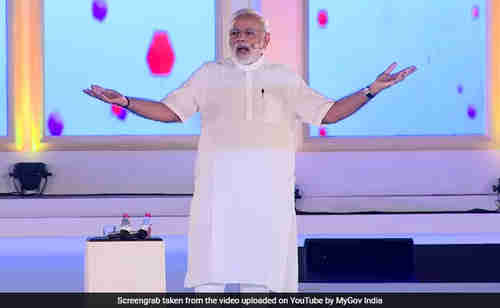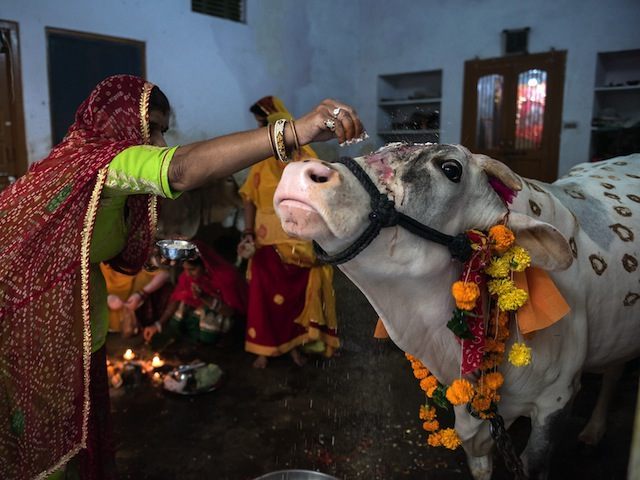This morning’s key headlines from GenerationalDynamics.com
- India’s Narendra Modi finally hits out at Cow Protectors (‘Gau Rakshaks’)
- Generational history of cow protection in India and Hinduism
India’s Narendra Modi finally hits out at Cow Protectors (‘Gau Rakshaks’)

Narendra Modi on Saturday (NDTV)
Under political pressure, India’s prime minister Narendra Modi broke his silence on “gau rakshaks” (cow protectors), after four Dalits (low-caste “untouchables”) in Gujarat were brutally beaten by vigilante gau rakshaks for allegedly killing a cow, which later investigation revealed to have been killed by a lion.
At a townhall meeting on Saturday, Modi said:
I get so angry at those who are into the Gau-Rakshak business. A Gau-Bhakt (cow devotee) is different, Gau Seva (cow protection) is different. I have seen that some people are into crimes all night and wear the garb of Gau Rakshaks in the day.
70-80% will be those who indulge in anti-social activities and try to hide their sins by pretending to be Gau Rakshaks. If they are true protectors, they should realize that most cows die because of plastic, not slaughter. They should stop cows from eating plastic.
Eating of cows has been forbidden by Hinduism for three millennia, but in the current generational Crisis era, the question of protecting cows has become heavily tied into Hindutva, or Hindu nationalism, which sometimes is used to excuse violence towards Muslims, Christians and Dalits. ( “12-Oct-15 World View — India Hindus attack Muslims as cow slaughter incidents surge”)
Although Modi and his ruling Hindu-nationalist Bharatiya Janata Party (BJP) party have not supported or praised these attacks, they haven’t spoken out against them either, until Modi’s statement on Saturday. It’s possible that there may be a backlash in the days ahead from extreme nationalist members of his own party.
Pawan Pandit, who is chairman of one gau rakshak group, the Bhartiya Gau Raksha Dal (BGRD), defends his movement:
We are not anti-Muslim or anti-Dalit. We are a fraternity which wants to save the cow, because she is our mother… because that is what my religion, my parents, my holy book, taught me. …
“Forget that cow slaughter hurts our sensibility, forget that our holy book considers slaughter of cow as the biggest crime, forget that we are a majority… at least, look at the cow as the biggest source of economy for rural India. And look at the scientific reasons, the benefits of using its products—be it milk, urine or cow dung. I am not the one saying all this. International research claims so. America, in fact, has patented a cow urine drug.
As far as I can tell, there’s a parallel here between India and Pakistan. In India, Hindu nationalists can get somebody killed by falsely accusing him of defiling a cow, while in Pakistan, Muslim nationalists can get somebody killed by falsely accusing him of defiling the Koran. New Delhi Television and Indian Express and Live Mint (India)
Generational history of cow protection in India and Hinduism

Map of 1947 partitioning of British India into India and Pakistan (BBC)
The origins of the veneration of the cow in Hinduism can be traced back almost three millennia to India’s Vedic period. With the rise of the ideal of ahimsa (“noninjury”), the absence of the desire to harm living creatures, the cow came to symbolize a life of nonviolent generosity. In addition, because her products supplied nourishment, the cow was associated with motherhood and Mother Earth.
During the Medieval era, especially when the Muslim Mughal Empire was in power, there was always tension between Muslims, who consider pigs to be unclean, and Hindus, who consider cows to be venerated. This led to tensions during generational Awakening eras, and sometimes led to war during generational Crisis eras.
In the 1850s, veneration of cows became a major trigger in the extremely bloody generational crisis war, the 1857 Indian Rebellion, also called India’s First War of Independence from the British colonial power.
In the 1850s, the British East India Company, which was governing India, introduced a new sort of ammunition for a new model of the Enfield rifle.
To be loaded, this cartridge had to be torn open so that the powder it contained could be poured down the barrel of the muzzle-loading gun; because the soldier’s hands were full, this was done with the teeth. Then the bullet had to be rammed down the rifled barrel. To facilitate its passage, the cartridges were greased with tallow, which was made of beef and pork fat.
These cartridges were used by British soldiers, and were also issued to sepoys (Indian soldiers) who served under the command of the British army. There’s some dispute as to whether the cartridges issued to the sepoys were also greased with beef and pork fat, but there’s no doubt that once the issue became public and suspicions were raised, rumors spread rapidly among the sepoys that the British were defiling their bodies and destroying their lives by breaking their castes, which was the punishment for eating beef. The Muslim sepoys were also offended that they had been eating pork fat.
This was a generational Crisis era, and anti-British xenophobia and nationalism were already high, but the greased cartridges triggered riots and mutinies that spread across India. The war lasted over two years and resulted in hundreds of thousands of deaths.
There were dramatic changes during the Recovery Era that followed the end of the war. The British Indian Empire was created out of the former East India Company, and India was under the direct rule of the British Crown. However, the Indian tribes and families were given a great deal more autonomy. There was a blossoming of culture, with new universities, colleges and schools opened by Indians, and there was new technology, including new railroads and irrigation systems.
However, it’s typical of the government in such situations to do everything possible to prevent anything so horrible from happening again, and in this case it meant harshly suppressing any dissent, even jailing protestors. It’s remarkable that of the histories of the 1857 rebellion that were written in the following decades, they were all written by British authors, and almost never by Indian authors.
The first major Indian account of the 1857 Rebellion was by a young Hindu activist named Veer Savarkar, whose book, “The Indian War Of Independence-1857” was published in 1909, and contained descriptions like the following:
[England] seized the innocent Hindu villagers, sentenced them to be hanged, and then pierced them with bayonets, and then, Heavens! thrust beef dripping with blood – the blood of the cow – down their throats, at the point of the bayonet – a desecration to which they would have preferred being hanged and, even, being burnt alive?
Savarkar was jailed for insurrection, and later became an extremely violent Hindu nationalist terrorist, and started the Hindutva movement which still exists today.
There were two other well-known figures that came out of the generational Awakening and Unraveling periods following the rebellion: Mahatma Gandhi, the Indian peace activist, and Muhammad Ali Jinnah, who became the founder of Pakistan.
Gandhi launched a “non-cooperation movement” against the British, involving civil disobedience. The Awakening era climax occurred on April 10-12, 1919, with the Jalianvala Bagh Massacre (Amritsar Massacre), when British troops opened fire on 10,000 Sikhs holding a protest meeting, killing hundreds. That event convinced both the British and the Indians that Britain should completely give up control of India.
Cow protection had already started again as a symbol of Hindu nationalism as early as 1882, as cow protection societies began to be formed at that time. Cow protection became more and more important as a nationalist symbol in the following decades, as a decision was made for India to leave the British empire and become an independent state.
The debate in 1946 following World War II centered on two choices: Should there be a single Indian state, with separate regions under the control of Muslims and Hindus, or should there be a two-state solution, a Muslim state living side-by-side in peace with a Hindu state? The argument that won the day was that Muslims can’t stand pigs and Hindus can’t eat cows, and so they can’t live together. Finally, Jinnah and Gandhi agreed that there had to be two separate states, India and Pakistan.
The 1857 rebellion was still fresh in everyone’s mind, and it was believed that a new war could be avoided by Britain giving up control of India. If Britain had tried to keep India as part of the British empire, then there might well have been a new war similar to the 1857 rebellion. So that was prevented, but in a generational Crisis era, you have the rise of young generations with no memory of the past, a feeling of invulnerability, and a desire for war — any war.
So India and Pakistan were created, leading to the 1947 Partition war between Muslims and Hindus, possibly the largest and bloodiest battle of the 20th century, eclipsing the bloodiness of the 1857 Rebellion. This is an example of the saying, “History doesn’t repeat itself, but it rhymes.”
Since then, India and Pakistan have fought three wars. One of these, the 1971 war in Bengal (East Pakistan) was a generational crisis war that created the nation of Bangladesh. ( “3-Jul-16 World View — Bangladesh tries to recover from Dhaka terror attack, the worst in 40
years”)
Today, Hindu nationalism is again rising, and it will undoubtedly have the same result that it had in 1947 and 1857. Britannica and Smithsonian and BBC
KEYS: Generational Dynamics, India, Narendra Modi, gau rakshak, Gujarat, Bharatiya Janata Party, BJP, Bhartiya Gau Raksha Dal, BGRD, Muslims, Hindus, Dalits, Christians, Hindutva, Mughal Empire, 1857 India Rebellion, India’s First War of Independence, British East India Company, Enfield Rifle, Veer Savarkar, Mahatma Gandhi, Muhammad Ali Jinnah, Pakistan, 1947 Partition war, 1971, Bangladesh
Permanent web link to this article
Receive daily World View columns by e-mail

COMMENTS
Please let us know if you're having issues with commenting.